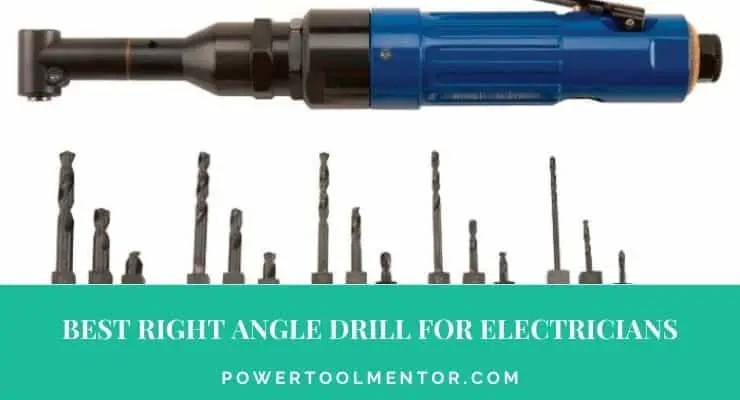You will find a right angle power drill is on every electrician’s Christmas list. It makes it easy for them to reach those spaces that like behind joists and beams that they wouldn’t otherwise reach without discomfort.
A right angle drill, also referred to as a 90 degree is not your average tool if you’re not a handyman. It’s a specialized drill that a professional electrician or plumber will use when the space is limited for fitting in a standard drill. What makes it special? Well, this tool has a 90-degree design to the grip, with the back of its head not rising above its grip line, allowing you to drill in tight and confined spaces. For example, screwing and drilling between joists and studs can prove difficult or even impossible for your average drill. With a right angle power drill, you drill any hole or drive in screws in the same position.
Best Right Angle Drill for Electricians – A Comparison Table
| Image | Model | Features | Check on Amazon |
|---|---|---|---|
 | DEWALT DCD740B 20V MAX Right Angle Drill | It's cordless It uses a 20V battery The material is steel It has a dual-speed range of 650 & 2000 RPM It comes with a compact length of 4 inches It weighs 3.25 pounds | Check Price Check On Amazon |
| Milwaukee 2615-20 M18 Right Angle Drill | It's made from steel Weighs 2.75 pounds It's powered by an 18V battery It comes with an inbuilt LED light It's cordless It includes a 5-year warranty | Check Price |
|
 | Makita DA3010F Right Angle Drill | It's corded It comes with a powerful motor of 4.0 Amp It weighs 4.14 pounds It has a 24000 RPM speed It has a length of 10-⅝ inches It comes with built-in LED lighting | Check Price Check On Amazon |
 | Makita XAD03PT 18V Right Angle Drill | It's powered by 2 LXT batteries of 36 volts It weighs 29 pounds It has speeds of 350 and 400 RPM | Check Price Check On Amazon |
 | Bosch PS11-102 12-Volt Right Angle Drill | It weighs 2.4 pounds It has a speed of 1300 RPM and a torque of 115 inches/pounds It's powered by a 12V battery | Check Price Check On Amazon |
1 – DEWALT DCD740B 20V MAX Right Angle Drill
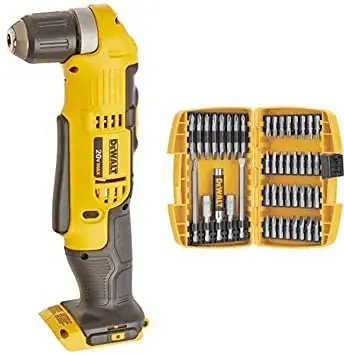
For a compact and tough 90-degree drill, this DEWALT DCD740B Right Angle Drill comes top of our head. It has a length of just 4 inches from front to the back that allows you to fit it in real compact and tight places like in a cabinet and uses a 20V battery to power its dual-speed ranges of 0- 650 RPM and 0-2000 RPM. This makes it very useful and flexible for a wide array of projects. With its ⅜ – inch chuck comes a deep hex pocket that allows you to insert fully 2-inch hex bits for use in attempting to reach hard areas.
Pros
- It’s easy to use and handle
- It’s lightweight and has a solid sturdy
- It’s compatible with all Dewalt 20V batteries
- The chuck size offers versatility
- It’s cordless making it portable
- Its dual speeds are reversible and offer a smooth control
- It can easily fit in a bag and leave room for extra accessories
Cons
- The trigger may not be continuous
- It overheats/burns up
View price on Amazon
2 –
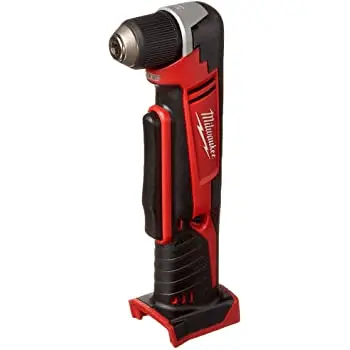
Several right-angle drills use low-power motors which won’t give you much drilling power as an electrician. This drill stands out on the market because of its Innovative Electronic Clutch powered by REDLITHIUM™ Battery Technology to deliver up to 125 inches/pound of torque using an 11-speed setting. Also, you get a drill mode that gives you complete control in fastening applications. REDLITHIUM™ Battery Technology significantly improves its battery lifespan and saves you on costs. On chucks, it comes with a ⅜ -inch chuck that’s easy to operate and lets you get through your tasks much faster. In terms of convenience, provides you with the lighting you need in dark or poorly lit spaces using an inbuilt LED light that illuminates the working area. It uses the exclusive REDLINK™ Intelligence to protect your drill, battery, and charger by using a cohesive communication mechanism to optimize performance and protect against overload.
Pros
- It’s lightweight
- It provides a 5-year warranty
- It comes with LED lighting
- It has a powerful speed
Cons
- It doesn’t include a charger and a battery
3 – Makita DA3010F Right Angle Drill
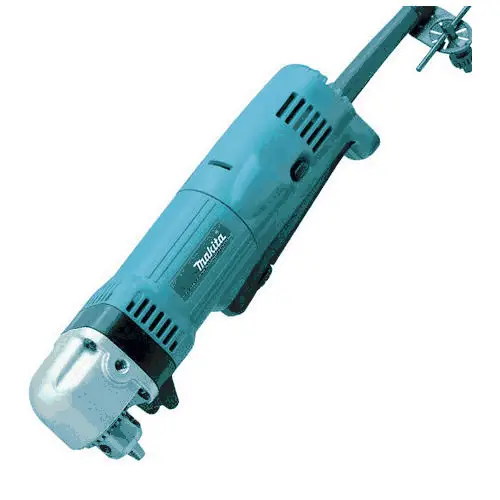
Makita DA3010F right-angle drill is made of metal and comes corded and equipped with a powerful 4 Amp ball-bearing motor for longevity that provides a maximum variable speed of 2400 RPM that makes the drill versatile for a wide range of applications. Its compact design and lightness make it easy to use in tight areas like inside a cabinet. To illuminate your working area, it includes a bright LED light that is never in need of a replacement throughout its lifespan. It also comes with a paddle switch that has a speed-limiting dial to prevent over-tightening of fasteners. The handle is a side grip to offer you better leverage.
Pros
- It has a sturdy construction
- It has an ergonomic design to reduce fatigue
- It’s lightweight and offers versatility
Cons
- The cord may limit your movement
- The chuck may not hold the drill bits in place
- The speed control is not steady
View price on Amazon
4 – Makita XAD03PT 18V Right Angle Drill
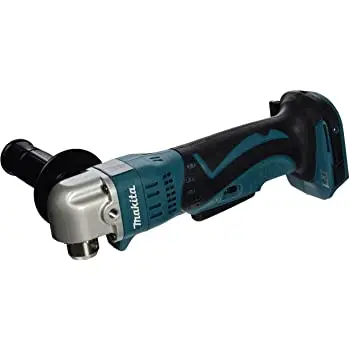
This Makita cordless drill is an absolute beast on a job site that will make most electricians fall in love with it when drilling a 1 – ¼ – inch hole for your project or even a 6-¼ inch hole. It comes with Makita brushless motors that provide you with variable speeds of 350 and 1400 RPM powered by 2 LXT Lithium-ion batteries to give them the versatility for several projects. When fully-charged, the batteries can provide you with enough power to drill 160 2-9/1-inch holes with the help of a self-feed bit. To enable you to adjust the torque and speed while drilling, the drill has an automatic speed technology feature for improved performance. The included components it comes with besides the batteries are a charger, side handle, chuck key, wrench, and a tool bag. It comes with a 3-year warranty.
Pros
- It’s easier and safer to use
- It comes with 2 batteries and a charger
- It provides more torque compared to standard drills
- Long-lasting battery span
- It’s a top-quality heavy-duty drill
Cons
- It heavy
- It lacks fully-controllable speed settings
View price on Amazon
5 – Bosch PS11-102 12-Volt Right Angle Drill
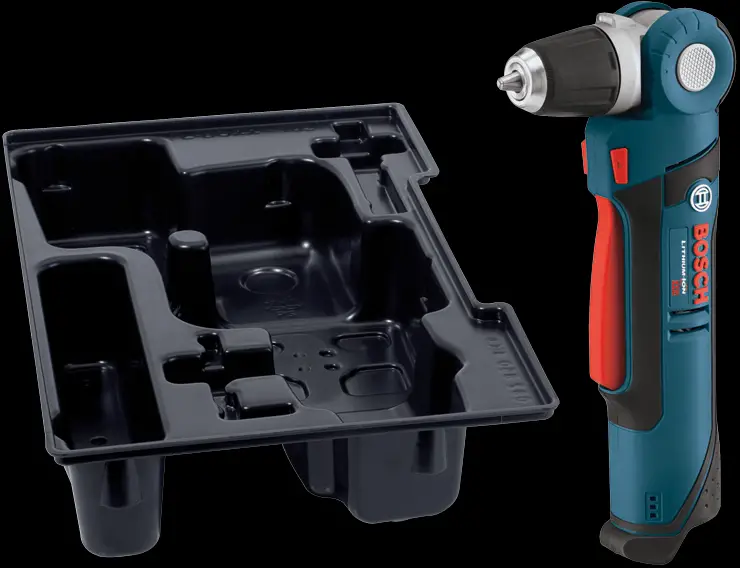
The Bosch PS11-102 Right Angle Drill uses a 12V motor that produces 1300 RPM maximum speed and a torque of 115 inches/pounds. This large variable trigger allows you to adjust the motor speed easily by varying the amount of force you exert on the trigger. It has a 5-position pivoting head perfect for tight areas as it allows you to pivot the head from 90-degree positions to 180 degrees. Meaning, you can have a straight power drill that you can use in even the tightest of spaces by simply straightening the drill head. It also utilizes a ⅜ – inch auto keyless chuck for changing your drill bits without the hassle and a motor brake that is applied when you release the trigger hence no further screwing and driving of screws.
Pros
- It offers versatility as it can be used at 45, 90, or 180 degrees
- It’s powerful
- It’s cordless and lightweight hence portable
- The battery is easy to remove and replace
- It comes with an LED light
Cons
- It’s not beginner-friendly
- The torque is not adjustable
- The battery isn’t that powerful and durable
View price on Amazon
Buying Guide for the Best Right Angle Drill for Electricians
-
Corded vs cordless
Power drills are available in two types – corded and cordless. Corded drills use power directly from the source whether an electric or a generator while Cordless drills use rechargeable batteries. Since you’ll use this right angle drill in confined spaces, you’ll need a lot of maneuvering to access the place. A cordless drill will give you just that but at a cost of power given that a corded one will provide you with more power.
-
Power
It is the most important aspect to consider in a drill regardless of the type of drill. Its performance depends on the source of power – a battery or a cord. A battery is used on a cordless drill and needs to be recharged while a cord is for a corded power drill and is plugged into a power outlet. Cordless drill power is measured in volts while for a corded drill it is measured in amps. Corded drills will give you more power considering they get it directly from the power source while cordless will give you the flexibility to maneuver and use on various job applications.
-
Drill size
Whether you go for a dedicated power tool or a tool attachment for your existing tools, you should check the right angle drill’s size to ensure you don’t face problems while using any compatible drill bits. Drills come with chucks that hold the drill bits in place when drilling or screwing and vary in sizes from ¼ to ½ inches with a ⅜ – inch chuck size found on almost 80% of all power drills and can often hold up to a ¾ – inch bit. These chuck sizes are compatible with drill bit sizes less than or equal to them. The larger the drill bit, the more torque your drill will require. A chuck of ½ an inch will need more torque to drive in a larger bit size.
-
Chuck type
Drill chucks exist in four major types; SDS, hex, keyless, and keyed, with keyless being the most common in modern drills. SDS chucks have a design made mostly for hammer drills and can rarely be found on right-angle drills while hex is uncommon because they can only hold screwdriver bits and not drill bits. With keyless and keyed chucks, you can drive both screws and drill holes. However, with keyed chucks, you’ll need to use a key to tighten or loosen the bits, and changing bits can take more time but they are more durable. Keyless on the other hand offers you convenience and allows you to quickly change any bit types or sizes, but it doesn’t have the same firm grip as a keyed chuck and wears out more quickly.
-
Speed and torque
For performance, the motor speed and torque are important things to check when buying a right angle drill. These two have an inverse relationship with a higher RPM giving you a lower torque and vice versa. Most drills have a variable speed setting that allows you to adjust your speed and torque based on your needs. When using the drill and need more resistance, the torque is important especially for hard grade wood and other dense materials. More speed is better when driving screws or drilling into softer material that isn’t quite dense. How do you determine what torque or speed to use? Most drills come with a switch or knob to shift the more towards the torque or speed.
-
Clutch
This is an adjustable dial that is found at the end of a drill before the chuck and is labeled with a ring of numbers. It helps you drill to the point that you need to and won’t go any further. It does things by determining how much resistance the drill will tolerate before disengaging which ensures the motor remains in good working condition as well as preventing you from stripping the screw.
-
Design
Ergonomically, a right angle drill will be determined using the weight, grip, and handle. Most drills come with a soft or rubberized grip to give you the comfort to drill for long. They come in different forms including D-handles, barrel, and sidewinders. The grip depends on how hard the handle is.
-
Lights
This is a secondary consideration of most power tools. However, given the nature of a right angle drill, it is an important thing to consider. A right angle drill is meant for reaching tight spaces that are otherwise difficult to reach.
-
Extra features
The common extras that come with a drill include bit holders, belt clips, and a carrying bag making this a tertiary aspect to consider. A case is good for portability but can be bought separately at a cheap cost.
FAQs
What is the difference between a right angle drill and a standard one?
Both drills are very similar and work with the same drill bits. The only difference is that for a right angle drill, its head has been designed in a 90-degree position to fit in tight places.
What do electricians use a right angle for?
Electricians usually work in tight spaces that might be difficult to drill in. A right angle drill’s 90-degree head makes it compact to be accommodated in these spaces.
Conclusion
The best right angle drill for electricians is one that meets your specific needs. The right-angle drills listed above all have something to offer and deliver excellence at an unbeatable price point.
